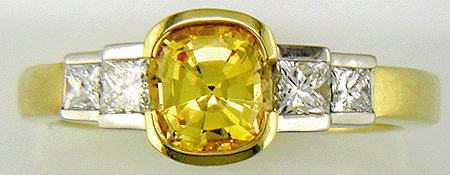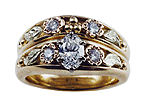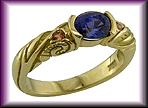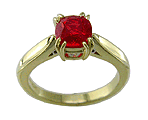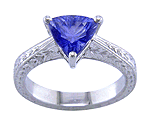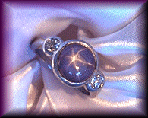
|
|
Issue 1, 2005
If you enjoy our newsletter, please sign up to receive The Bijoux News on a regular basis. Happy reading! |
||
|
Arthur Anderson Editor |
||
|
**********
Sapphires .... Not Just for the Blues!
By Arthur Anderson
When we think of sapphires we imagine beautiful gemstones that sparkle with an intoxicating shade of blue. But, sapphires are not just for the blues! Sapphires can be found in a rainbow of exciting colors including daffodil yellow, teal green, royal purple and hot pink. Half the fun of creating jewels with sapphires is deciding which of the many colors to work with. "Designing fine jewelry with fancy colored sapphires is like drawing with the Deluxe Box of Crayola Crayons," notes Judi Anderson, our chief gemologist and jewelry designer. "There is always a color that is perfect for the jewel you are creating." The many varieties of sapphire, other than blue, are referred to as "fancy colored sapphires." To help you discover the many shades of sapphire, we offer the following color guide.
Feeling The Blues!
Sri Lanka, Madagascar, Thailand, Kashmir and even Montana are among the exotic and not so exotic locations that offer stunning blue sapphires. When it comes to blue sapphires you can find gems that range from pale, water-like pastels to deep royal blues and heavenly shades of the sky. When considering sapphires it is best to explore the full range of colors and varieties. Unfortunately, not all blue sapphires are equally beautiful. Occasionally, overly dark blue stones are promoted with romantic names like "Midnight Sky" and "Australian Blue." These "gems" are usually lower grade sapphires that are too dark to show the gemís true beauty. The prettiest thing about these stones are their exotic names. The most important aspect of a gemstoneís color is saturation. Richly saturated, royal blue sapphires command higher prices than the dark, inky blue stones often found in mass-produced, "cookie cutter" jewelry.
Pretty In Pink!
Pink sapphires can be found in a subtle rose blush, cool icy pink and hot vibrant fuchsia. In the last couple of years, exceptional pinks have been found in the bountiful gem deposits of Madagascar. These neon-like gems make wonderful center and accent stones that look especially good when set in cool white gold and platinum. Even small pink sapphires can display intense color.
Not So Mellow Yellow!
Yellow sapphires offer a broad range of colors including light pastels, bright lemons and "not so mellow" golden yellows that glow with a hint of orange. The lighter shades of yellow look best set in white gold and platinum, while the warmer hues like deep golden yellow and orangy-yellow come to life when set in 18kt and 22kt yellow gold. Fancy yellow sapphires often rival yellow diamonds in the intensity and beauty of their color.
Purple Passion!
One of our favorite fancy shades of sapphire is purple. These regal gems range from pastel lavenders and lillacs to rich royal purples. Particularly fine examples have been found in the Tunduru region of East Africa and among the rich gem deposits of Madagascar. Some purple sapphires display a surprising color change. In candle and incandescent lighting these sapphires are purple or violet, while in sunlight their color changes to blue. Sapphires with a dramatic color change create striking jewels. Naturally, these versatile gems are ideal for daytime and evening wear!
Green with Envy!
Another shade of fancy colored sapphire is green. These gems range in color from subdued olives to rich blue-greens and teals. Although green sapphires often have a lower cost per carat than the other fancy sapphires, really nice green sapphires are hard to find. When we come across a striking green sapphire that really "pops," we simply cannot resist!
Paparazzi Padparadschas!
The most prized and rarest of the fancy colored sapphires are the Padparadschas (pronounced "pod-pa-rod-shas"). These celebrity sapphires are pinkish in color with secondary orange hues. They are traditionally from Sri Lanka, although sapphires of similar color have been found in other locations. The tongue twister of a name, "Padparadscha," derives from the Sinhalese word for lotus blossom, whose color is an irresistible mixture of pink with a hint orange. Sinhalese is the official language of Sri Lanka. The rarity and value of Padparadscha sapphires has attracted many pretenders. Some sellers misleadingly refer to orange sapphires without the necessary traces of pink as Padparadscha gems. Other sellers offer sapphires that have been treated with pink or orange coloring agents to artificially create a padparadscha-like color. When purchasing an important sapphire, or other gemstone, it is best to have the authenticity and value of the gem verified by an independent gemologist/appraiser.
Whiter Shade of Pale!
When you consider fancy color sapphires, do not forget the colorless or white variety. Colorless sapphires have an appearance like cool, clear water. Throughout history colorless sapphires have been used as substitutes for diamonds, but these gemstones have a charm all their own. Recently we custom created a ring for a client who was inspired by the jewels of ancient Egypt. The ring, aptly named "Jewel of the Nile," featured an oval colorless sapphire set like a shimmering, crystalline pool between two bright blue sapphires. In this design the colorless sapphire was the ideal center stone - a diamond would have been overpowering with too much fire and sparkle.
The Corundum Conundrum!
We have described sapphires in every color of the rainbow except one, red. This is because the gemstones we might think of as red sapphires are actually rubies. Both rubies and sapphires are varieties of the mineralogical species Corundum. Gem quality specimens of Corundum that are red are called rubies, from the Latin rubeus meaning red. All other shades of Corundum, including blue, are sapphires.
A Word of Caution
Sapphires, like all beautiful and rare gemstones, have attracted their share of imitators and adulterers. In the first century, Pliny the Elder observed "There is no fraud or deceit in the world which yields greater gain and profit than that of counterfeiting gems." What was true 2000 years ago is still true today. If you are considering the purchase of an important sapphire or other gemstone, you should have an independent gemologist/appraiser verify the authenticity, quality and value of the gems you are considering. As always, education and expertise are your best protection against the deceptions and shenanigans in the gemstone market place. If you would like to view some of the sapphires we have helped clients acquire and the jewels Judi has custom designed, please visit our Sapphire Ring Gallery.
**********
Rings with a Story
Rings are more than just objects of personal adornment and portable wealth. Since earliest times, rings have also served to tell the story of two people, how they met and their life together. Perhaps this tradition began in 1234 when King Louis IX of France joined in blissful union with Marguerite of Provence. To celebrate their marriage, the King had his goldsmith craft a special ring. The outside of the ring was decorated with a garland of entwined daisies and lilies. The daisies symbolized his wife ("marguerite" is the French word for daisy) and the lilies (the fleurs de lis) represented his kingdom. On the inside of the ring, Louis IX inscribed the motto "This ring contains all I love." The Victorians also loved jewels with special meanings. One style of ring would spell out a word or phrase using the initials of the gemstones. For example, a ring set with a Diamond, Emerald, Amethyst and Ruby would spell out "DEAR", or Lapis, Opal, Vermeil (a Victorian name for hessonite garnet and other reddish-orange gems), and Emerald for "LOVE". The gemstones might also spell out the wearerís name." This form of symbolism is known as "acrostic" jewelry. The Victorians also created "rebus" jewels in which elements of the design formed a picture puzzle. For example, a brooch featuring a honey bee, a golden knot and a cross ("X") would mean "Honey, be not cross!" No doubt given by a gentleman to his beloved after doing something exceptionally bad! The tradition of incorporating personal symbols and special meanings into rings and jewels did not end with the Victorian era. Over the past decade, we have helped a number of couples design rings that celebrate the story of how they met and their life together. We call these special jewels "story rings".
**********
Letter from Tucson
[ Editor's note: Each year Judi, our chief gemologist and jewelry designer, travels to the Tucson gem and mineral shows in search of beautiful gems and to contact new gem cutters from around the world. Below is her report from the 2002 shows. ] Each year my annual trip to Tucson is a whirlwind tour of the latest gemstone discoveries, recent developments in gemological science, and emerging market trends. The Tucson shows also allow me to find new sources for the beautiful gemstones we set in the jewels we create. Here is what I learned this year.
The big news in Tucson were rubies and fancy colored sapphires from the island nation of Madagascar. In recent years Madagascar has developed into a rich source for many beautiful gemstones. For example, fine quality rubies from Madagascar often rival the beauty and color of more costly rubies found in Burma. Madagascar is also the source of a rainbow of fancy colored sapphires. Among my favorites are vibrant pinks, simmering violets, cool lavenders, dazzling oranges and bright yellows. In Asia there is a new deposit of Red Spinels in the Namya region of Burma. The red spinels from this area often have a beautiful pinkish cast that gives the stones an inner glow. Although I must confess that red spinel is one of my favorite gemstones, these recently discovered gems are among the best I have seen.
Naturally, I picked up some very nice red spinels, fancy colored sapphires and fiery red rubies for our inventory. I look forward to creating jewels for these gems over the coming months. Tucson is also a time for gem cutters to showcase their latest creations. One on the latest trends in gem cutting is concave facetting. By slightly curving the normally flat facets of a gemstone, talented cutters like Richard Homer and Mark Gronlund are able to create gemstones with amazing brilliance. The effect is mesmerizing. We feature a trillium sapphire cut by Richard Homer set in one of our hand-engraved platinum rings on our web site.
Tuscon is also a chance to catch up on the latest controversies, rumors and shenanigans in the gemstone industry. This year the biggest buzz involved the recent influx of Padparadscha-like sapphires into the marketplace. True Padparadscha sapphires are rare gems that glow with an intoxicating pinkish orange color. It appears that gem dealers in Bangkok are taking natural orange sapphires and treating them to produce a Padparadscha like color. One step in this treatment appears to involve color diffusion. The result is to add a thin layer of pinkish color to the outer surfaces of the gem. When the treated stones are viewed face up, they appear to have the pinkish orange color characteristic of natural Padparadaschas. Unfortunately, the beauty is only skin deep. Finally, as many of you know I am a gadget person, especially when it comes to gemology and jewelry design. So in Tucson I spent some time researching jewelry design software. I am planning to implement CAD software in our jewelry design department so we can add to the range of designs that we can custom create. I am very excited about this project. Now my mission is to convince Arthur that we should spend roughly $10,000 for this fancy schmancy software.
Note - Many of the beautiful gemstones Judi saw in Tucson can be found in our Gemstone Gallery.
**********
Sapphires of the Stars!
Some exceptional sapphires and rubies display a six-rayed star, a phenomenon known to gemstone connoisseurs as "asterism." This star-like effect is created by thousands of needle-like inclusions crisscrossing the crystalline structure of the gem. Star sapphires and rubies are usually cut as polished domes ( en cabochon ) to showcase the star-like effect. Star sapphires were a great favorite among the movie stars of the 1920ís and 1930ís. Silent-film actress Mary Pickford treasured a 182-carat star sapphire, the Star of Bombay, given to her by her husband Douglas Fairbanks, Sr. She later donated this beautiful blue-violet gem to the Smithsonian's Museum of Natural History. Joan Crawfordís engagement ring, from husband number two of five, featured a 70-carat star sapphire. Incidentally, husband number two was Douglas Fairbanks, Jr. Clearly the Fairbanks men knew the alluring power of a star sapphire. To complement her betrothal bauble, the star of "Grand Hotel" favored a bracelet set with three equally stunning star sapphires each weighing 73 carats, 64 carats and 58 carats. Clearly she felt these gemstones had "Star Quality!" On the other hand, Jean Harlow was less fortunate. In 1936, leading man William Powell proposed to her with a beautiful, but traditional, diamond ring. Harlow accepted the proposal, but refused the ring. The platinum blond actress felt a large star sapphire would better fit her glamorous life style. Powell, no doubt chagrinned that his first ring was rejected, acquiesced and purchased a large star sapphire, but one of lower quality. This time the ring was accepted and Harlow proudly displayed the bauble in her final film, Saratoga. Tragically, she died several months later at the age of 26. In the tradition of beautiful star sapphire rings from the 1920s and 1930s, we have created several rings for clients featuring this stellar gemstone.
**********
Thank you for reading The Bijoux News. If you have any suggestions, questions, please send Art Anderson, the editor, an e-mail. Please feel free to share this newsletter with your friends or to make copies for your personal use. However, no part of this newsletter is to be used for commercial or other purposes without the express written consent of Bijoux Extraordinaire, Ltd.
Other issues of The Bijoux News can be found the Bijoux News Archive.
|
|
|
||
|
| Reading Room | Jewelry Galleries | What's New! | | Bijoux Home Page | About Us | Services We Offer | Site Map | If you have any questions, suggestions or comments, please give us a call (603 624-8672) or send us an email.
|
||
|
"The Jewelry Experts" and "The Jewelry Expert" are Trade Marks of Bijoux Extraordinaire, Ltd. © Copyright Bijoux Extraordinaire, Ltd.
|
||
